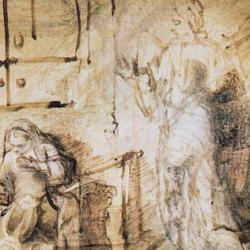At several points in Galatians, Paul distinguishes between the Abrahamic promise and the Mosaic Torah. He charges that his opponents want to return to the obsolete Mosaic system by forcing circumcision on Gentiles.
Problem is, circumcision was given to Abraham, not Moses. It seems to be a sign of the promise, not an imposition of the law.
Surely Paul knows this. So why does he set things up the way he does? Doesn’t he leave himself open to the counter-argument that his opponents are making Gentiles sons of the promise precisely by imposing circumcision?
To answer this, we need the connection between Paul’s contrast of Abraham and Moses on the one hand, and the allegory of Abraham’s two wives on the other.
In the course of the letter, Paul lines up Abraham and Torah as one pair in a series of oppositions:
1_ Abrahamic promise vs. Mosaic Torah.
2. Promise received by faith vs. “Live by commandments.”
3. Blessing vs. curse.
4. Spirit vs. flesh.
The allegory at the end of Galatians 4 is structured by a very similar series of oppositions:
1. Hagar vs, Sarah.
2. Sinai/present Jerusalem vs. Jerusalem above.
3. Slave vs. free.
4. Flesh vs. Spirit.
Paul understands the life of Abraham as an allegory of the history of Israel, and his contrast of the Abrahamic promise and the Mosaic Torah is worked out within that allegory of Genesis. In Galatians 4, Paul doesn’t mention circumcision and when we put it in place, it seems to undermine Paul’s argument. Between the birth of Ishmael and the birth of Isaac, Abraham was circumcised. That cut in the flesh could arguably be the thing that makes Abraham the father of the child of the Spirit. If you want to beget Spiritual children, you need to be circumcised. I think Paul’s allegory has an answer to that, and I have dealt with it here.
For my purposes here, it’s enough to note that Paul allegorized the life of Abraham differently in other passages of Paul. In Romans 4, Paul asks in what state Abraham was when he was declared righteous, and the answer is that he was uncircumcised. Circumcision became a seal of the righteousness that he had while uncircumcised. In this way, Abraham becomes the father of both circumcised and uncircumcised, those who share the faith of Abraham. Abraham embodies the union of Jew and Gentile because He is righteous by faith, and then circumcision comes along to seal that “Gentile” righteousness. In this allegorization of Abraham, circumcision is late and secondary, something added to Abraham’s calling and Yahweh’s promise.
We take this logic to Galatians 3. There, Paul observes that God promised that the nations would be blessed in Abraham. Abraham believed that promise, and God reckoned him righteous. Though Paul does not mention it in Galatians, that promise and that reckoning were given while Abraham was uncircumcised. Circumcision comes later in the story of Abraham, as it comes later in the history of Israel.
Circumcision creates a cut in the human race, dividing Jews from Gentiles, but that cut in the race doesn’t nullify the original promise and blessing. Circumcision is on the side of the law because it is one of the things that divides among the nations; it is a cut in the flesh that establishes a fleshly system. It’s the foundational rite that prevents Israel from being the “one seed,” even though Israel is an instrument for producing the one seed. Circumcision is thus associated with Torah within the Abrahamic narrative, so long as the Abrahamic narrative is understood as an allegorical preview of Israel.















